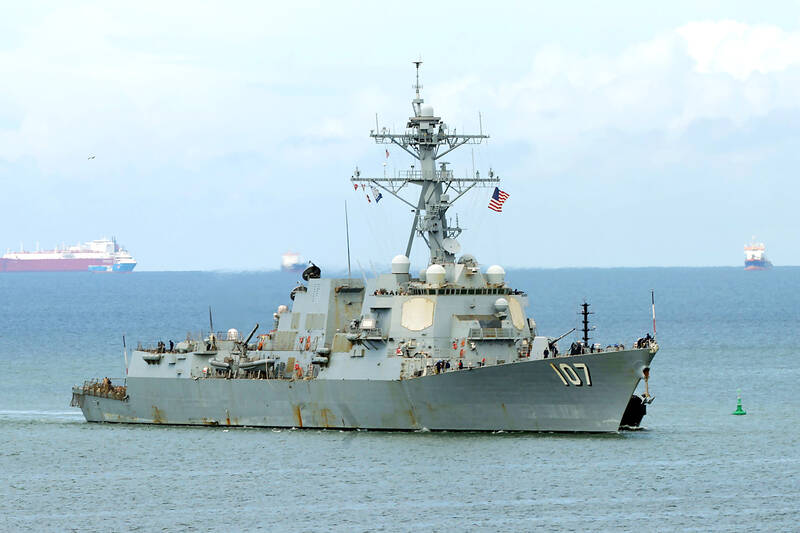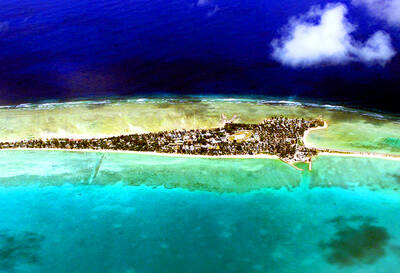Venezuela on Sunday blasted the arrival in nearby Trinidad and Tobago of a US warship as a dangerous “provocation,” amid mounting fears of potential attacks against the Venezuelan mainland.
The USS Gravely, a guided missile destroyer, docked on Sunday in the Trinidadian capital, Port of Spain, for a four-day visit, which would include joint training with local defense forces.
The ship’s arrival comes amid a mounting military campaign by US President Donald Trump against alleged drug-traffickers in Latin America, which has largely targeted Venezuelans and so far been limited to deadly strikes in international waters.

Photo: EPA
Trump has increasingly threatened to take the campaign on land, while Venezuelan President Nicolas Maduro claims Washington is plotting his ouster.
Trinidad and Tobago, which is situated just 11km from the Venezuelan coast at its closest point, has sided with Washington against its neighbor.
Venezuela angrily denounced “the military provocation of Trinidad and Tobago, in coordination with the CIA, aimed at provoking a war in the Caribbean.”
Caracas added that it had arrested “a group of mercenaries” with links to the CIA, days after Trump said that he had authorized covert CIA operations against Venezuela.
Maduro’s government claimed the alleged mercenaries were mounting a “false flag attack” aimed at provoking a full-blown war, without giving details.
Venezuela regularly claims to have arrested US-backed mercenaries working to destabilize Maduro’s administration.
The USS Gravely is one of several warships Washington deployed to the Caribbean in August as part of an anti-drugs campaign that Venezuela sees as a front for trying to topple Maduro, whose re-election Washington rejects as fraudulent.
Tensions escalated sharply on Friday last week when the Pentagon also ordered the deployment of the world’s biggest aircraft carrier, the USS Gerald R. Ford, to the region.
US forces have blown up at least 10 boats they claimed were smuggling narcotics, killing at least 43 people, since last month.
The standoff has pulled in Colombian President Gustavo Petro, a sharp critic of the US strikes who was sanctioned by Washington on Friday last week for allegedly allowing drug production to flourish.
Caracas has accused Trinidad and Tobago, a twin-island nation of 1.4 million people whose Prime Minister Kamla Persad-Bissessar is fiercely critical of Maduro, of serving as “a US aircraft carrier.”
Trinidad and Tobago said the visit of the USS Gravely “aims to bolster the fight against transnational crime, and build resilience through training, humanitarian activities and security cooperation.”
Trinidad and Tobago values its relationship “with the people of Venezuela” and remains committed to “the creation of a safer, stronger and more prosperous region,” a government statement said.
In Port of Spain, some people welcomed the government’s show of support for Trump’s campaign, but others worried about getting caught up in a regional conflict.
“If anything should happen with Venezuela and America, we as people who live on the outskirts of it ... could end up getting a lash any time,” 64-year-old Daniel Holder said.
“I am against my country being part of this,” he said.
Victor Rojas, a 38-year-old carpenter who has been living in Trinidad and Tobago for the past eight years, said he was worried for his family back home.
“Venezuela is not in a position to weather an attack right now,” he said, referring to the nation’s economic collapse under Maduro.

DISASTER: The Bangladesh Meteorological Department recorded a magnitude 5.7 and tremors reached as far as Kolkata, India, more than 300km away from the epicenter A powerful earthquake struck Bangladesh yesterday outside the crowded capital, Dhaka, killing at least five people and injuring about a hundred, the government said. The magnitude 5.5 quake struck at 10:38am near Narsingdi, Bangladesh, about 33km from Dhaka, the US Geological Survey (USGS) said. The earthquake sparked fear and chaos with many in the Muslim-majority nation of 170 million people at home on their day off. AFP reporters in Dhaka said they saw people weeping in the streets while others appeared shocked. Bangladesh Interim Leader Muhammad Yunus expressed his “deep shock and sorrow over the news of casualties in various districts.” At least five people,

ON THE LAM: The Brazilian Supreme Court said that the former president tried to burn his ankle monitor off as part of an attempt to orchestrate his escape from Brazil Former Brazilian president Jair Bolsonaro — under house arrest while he appeals a conviction for a foiled coup attempt — was taken into custody on Saturday after the Brazilian Supreme Court deemed him a high flight risk. The court said the far-right firebrand — who was sentenced to 27 years in prison over a scheme to stop Brazilian President Luiz Inacio Lula da Silva from taking office after the 2022 elections — had attempted to disable his ankle monitor to flee. Supreme Court judge Alexandre de Moraes said Bolsonaro’s detention was a preventive measure as final appeals play out. In a video made

It is one of the world’s most famous unsolved codes whose answer could sell for a fortune — but two US friends say they have already found the secret hidden by Kryptos. The S-shaped copper sculpture has baffled cryptography enthusiasts since its 1990 installation on the grounds of the CIA headquarters in Virginia, with three of its four messages deciphered so far. Yet K4, the final passage, has kept codebreakers scratching their heads. Sculptor Jim Sanborn, 80, has been so overwhelmed by guesses that he started charging US$50 for each response. Sanborn in August announced he would auction the 97-character solution to K4

SHOW OF FORCE: The US has held nine multilateral drills near Guam in the past four months, which Australia said was important to deter coercion in the region Five Chinese research vessels, including ships used for space and missile tracking and underwater mapping, were active in the northwest Pacific last month, as the US stepped up military exercises, data compiled by a Guam-based group shows. Rapid militarization in the northern Pacific gets insufficient attention, the Pacific Center for Island Security said, adding that it makes island populations a potential target in any great-power conflict. “If you look at the number of US and bilateral and multilateral exercises, there is a lot of activity,” Leland Bettis, the director of the group that seeks to flag regional security risks, said in an